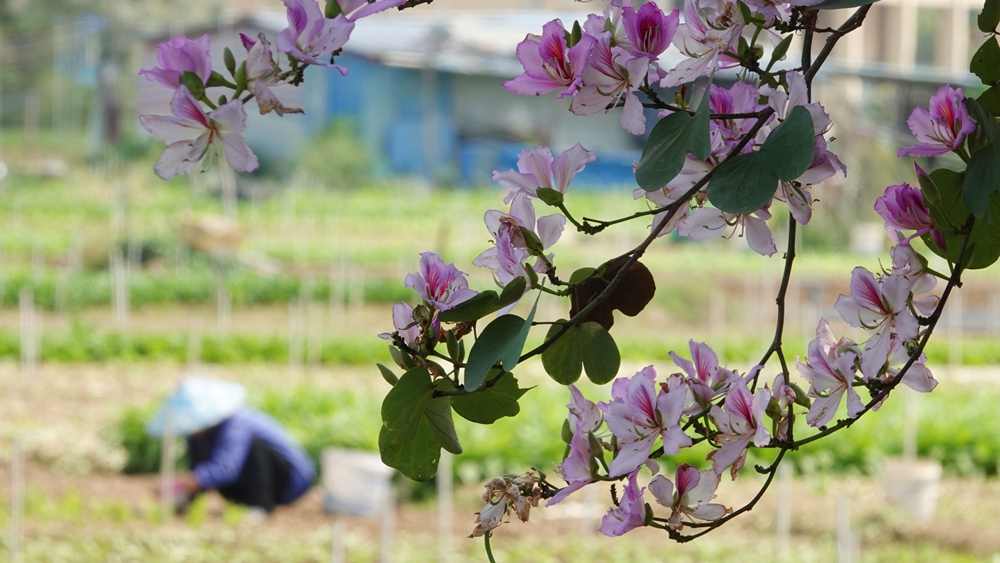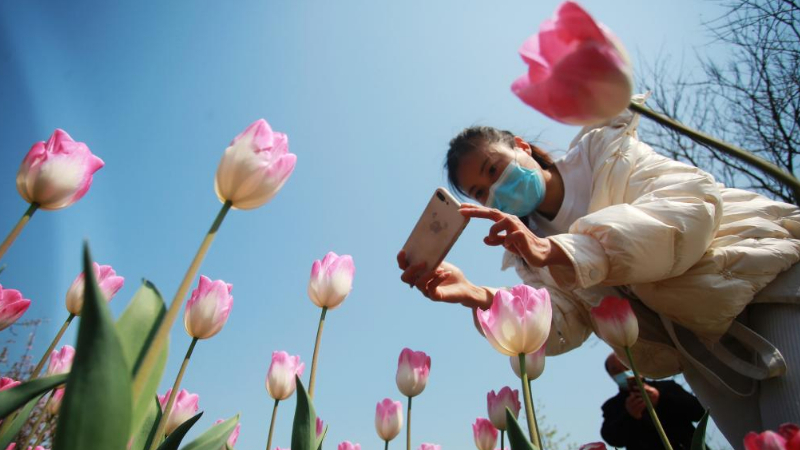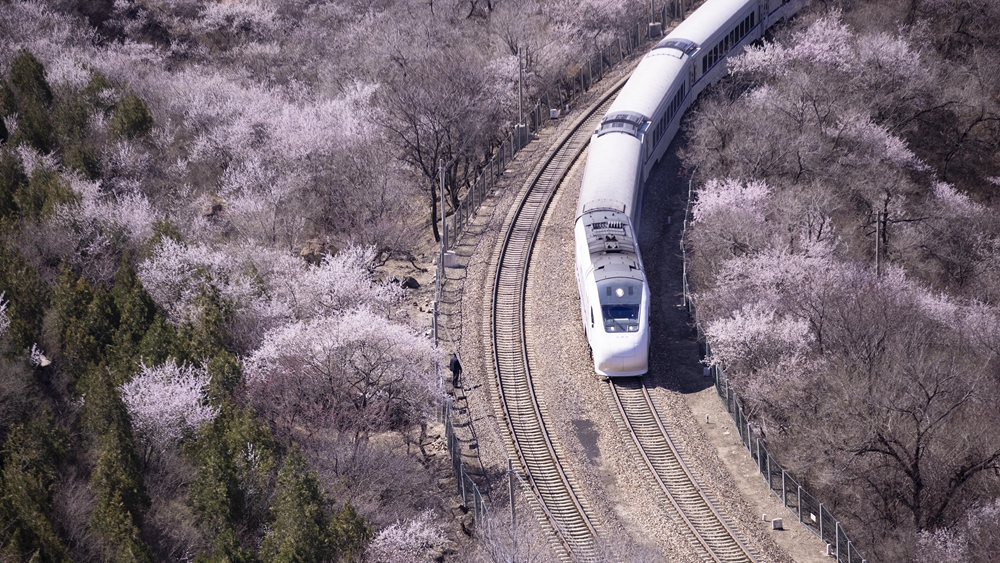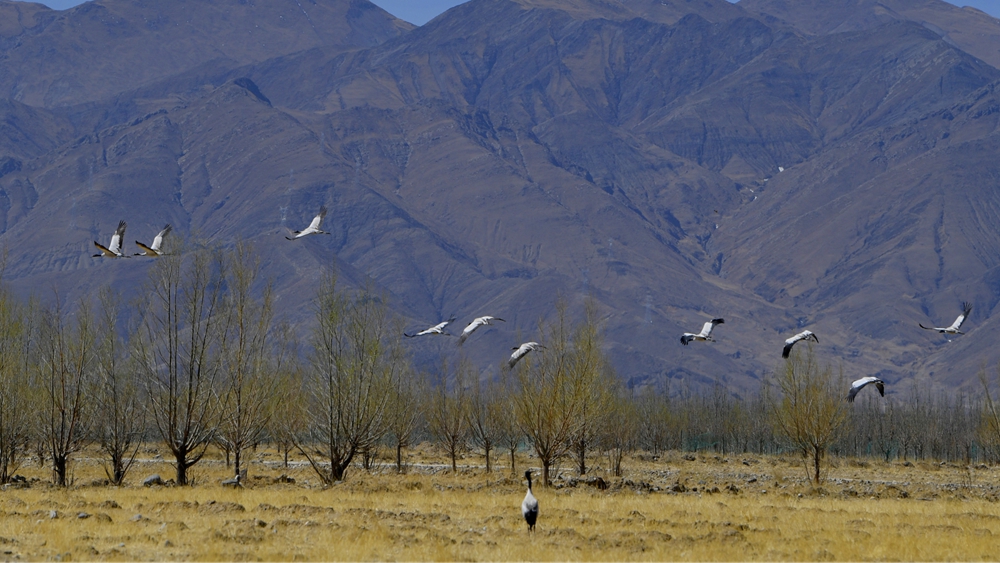* In March 2020, a herd of wild Asian elephants left a forest nature reserve in Xishuangbanna, southwest China's Yunnan Province, and trekked about 500 km northward to the provincial capital Kunming, arriving in June 2021.
* The reserve spans an area of 242,500 hectares, with no villages in its core area and still some scattered around.
* Experts have taken steps to accommodate the giants' movements by planting edibles, restoring forests and monitoring via technology.
KUNMING, March 21 (Xinhua) -- Two years after a herd of wild Asian elephants left their forest habitat in southwest China, an event that drew global attention, experts are working hard to keep them stay at home while avoiding conflict with the human population.

Wild Asian elephants are seen in the Wild Elephant Valley in Jinghong City, Xishuangbanna Dai Autonomous Prefecture, southwest China's Yunnan Province, on March 15, 2022. (Xinhua/Chen Xinbo)
In March 2020, the elephants left a forest nature reserve in Xishuangbanna, Yunnan Province, and trekked about 500 km northwards to the provincial capital Kunming, arriving in June 2021. They have since headed south again, arriving safely back at the nature reserve.
Their epic journey aroused a huge interest in the human world, and provided researchers with a chance for the study of human-wildlife conflict.
As many experts believe that it is inevitable that wild elephants will roam beyond the reserve, they have taken steps to accommodate the giants' movements by planting edibles, restoring forests and monitoring via technology.
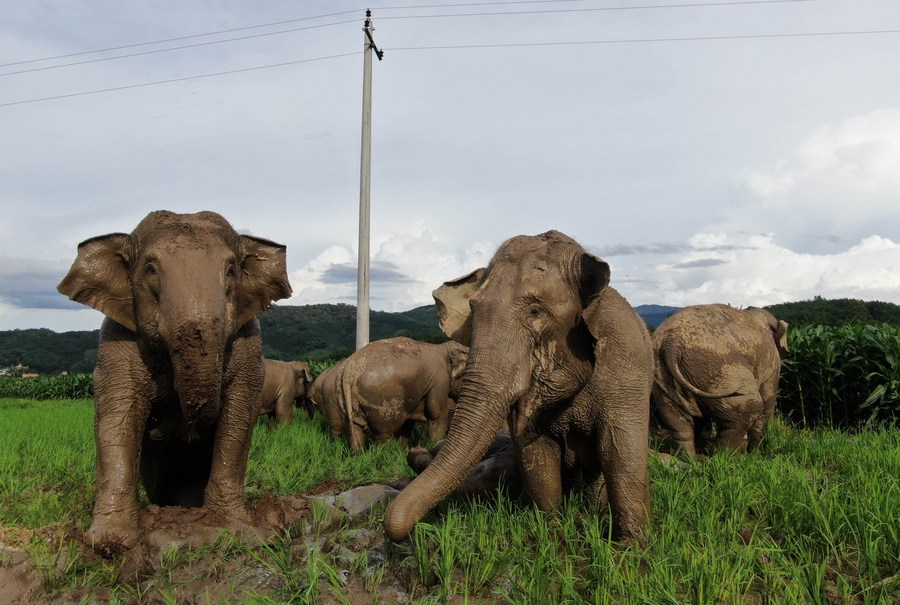
Wild Asian elephants are seen in farmland in Menghai County of Xishuangbanna Dai Autonomous Prefecture, southwest China's Yunnan Province, on July 17, 2020. (Asian elephant monitoring and warning center in Menghai County/Handout via Xinhua)
ROAMING FREE
Among the key issues is the tendency of these elephants, the population of which has exceeded 300, to wander in search of food, an activity that often takes them into the villages beyond the forest reserve. While the recent high-profile trek covered hundreds of kilometers, shorter trips are common.
The reserve spans an area of 242,500 hectares, which accounts for over 12 percent of the total land area in Xishuangbanna, with no villages in its core area and still some scattered around.
The nature reserve in Xishuangbanna doesn't have fences to stop elephants from leaving, which means people must pay attention to the environment near the reserve, anticipating how elephants will behave when they arrive at a village, said Chen Fei, director of the Asian elephant research center under the National Forestry and Grassland Administration.
"Elephant conservation requires big protected areas, big national parks as the core area, with a lot of management in their surroundings, because elephants will come out and there will be a lot of conflicts around this," said Jose Ahimsa Arceiz, an ecologist based at the Xishuangbanna Tropical Botanical Garden of the Chinese Academy of Sciences.

Jose Ahimsa Arceiz, an ecologist based at the Xishuangbanna Tropical Botanical Garden of the Chinese Academy of Sciences, speaks in an interview in Xishuangbanna Dai Autonomous Prefecture, southwest China's Yunnan Province, March 15, 2022. (Xinhua/Sun Min)
As the long trek illustrated, experts also have to make plans ahead, in case a small journey becomes a long one.
"Elephants have the ability to move over long distances, including in high-human-density places where you never think elephants would be," said Arceiz.
ELEPHANT CANTEENS
Resolving human-elephant conflict has never come easy. Data released by the Yunnan provincial administration of forestry and grassland shows that from 2013 to 2020, over 80 people were killed or injured by wild elephants, with over 250 million yuan (about 40 million U.S. dollars) of direct economic losses caused.
Among the key tools at the forest rangers' disposal is the establishment of food stores in multiple locations, dubbed "elephant canteens," providing the animals with attractive and nutritious meals. These can be used to keep them in certain locations and help save farmers' crops.
The creation of canteens was a key feature of the coverage of the big trek, and it is central to the management of the animals now that they are back home.
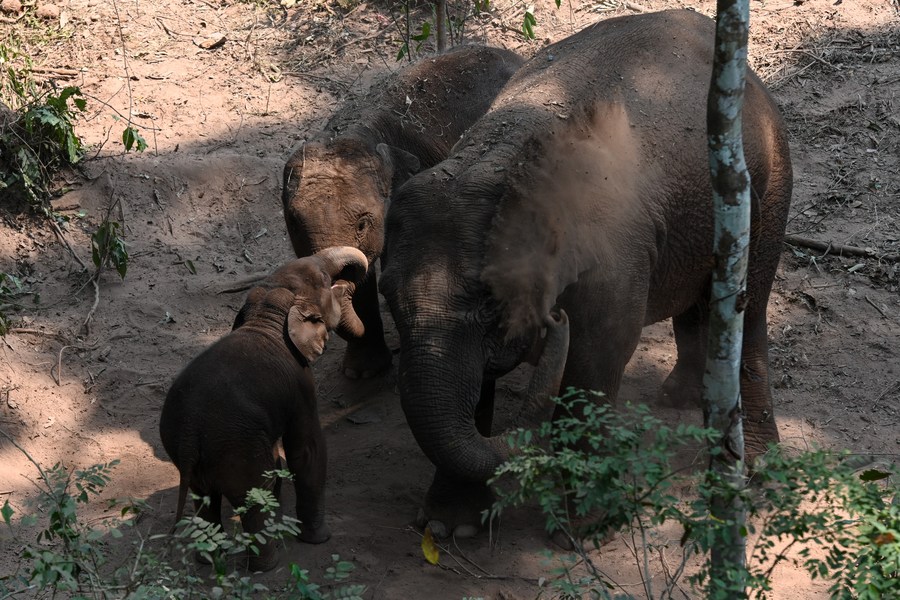
Wild Asian elephants are seen in the Wild Elephant Valley in Jinghong City, Xishuangbanna Dai Autonomous Prefecture, southwest China's Yunnan Province, on March 15, 2022. (Xinhua/Cao Mengyao)
In recent years, certain practices have been updated, said Guo Xianming, director of the scientific research institute with the Xishuangbanna nature reserve.
"We used to divide the farmland, with half used for planting and half of the land for the elephants' food," said Guo. "As a matter of fact, both fields would be eaten by the giants in the end."
The villagers living near the reserve reached the same conclusion.
"The elephants have become picky. The food in the 'canteens' was no longer attractive to them, and they now prefer corn over banana trees," said Dai Cunzhuang, a villager in Dahuangba, where encounters with wild elephants are frequent.
The solution, according to Guo, was to change the types of food being provided, favoring more natural options.
"Instead of planting corn and sugar cane, we began to plant edibles that the elephants normally find in the forest, thus reducing the elephants' fondness to farm produce," said Guo.
Rangers on the reserve also work to ensure the animals have access to nitrate-rich ponds, which can provide them with vital salts, as well as water to play in.
TECHNOLOGY
Another tool in the box is technology that helps to keep track of the animals' movements, providing fair warning of any encounters with human populations.

An infrared camera shows two wild elephants walking on a road in Menghai County in Xishuangbanna Dai Autonomous Prefecture, southwest China's Yunnan Province, Aug. 8, 2020. (Xinhua/Chen Xinbo)
Around 600 infrared cameras, 177 intelligent broadcast systems, and drones have been applied around those villages that have frequent elephant encounters.
Whenever infrared cameras or drones around villages detect elephants approaching, the local villagers get messages warning them of the giants' current location. They are then able to steer clear and make room for their arrival.
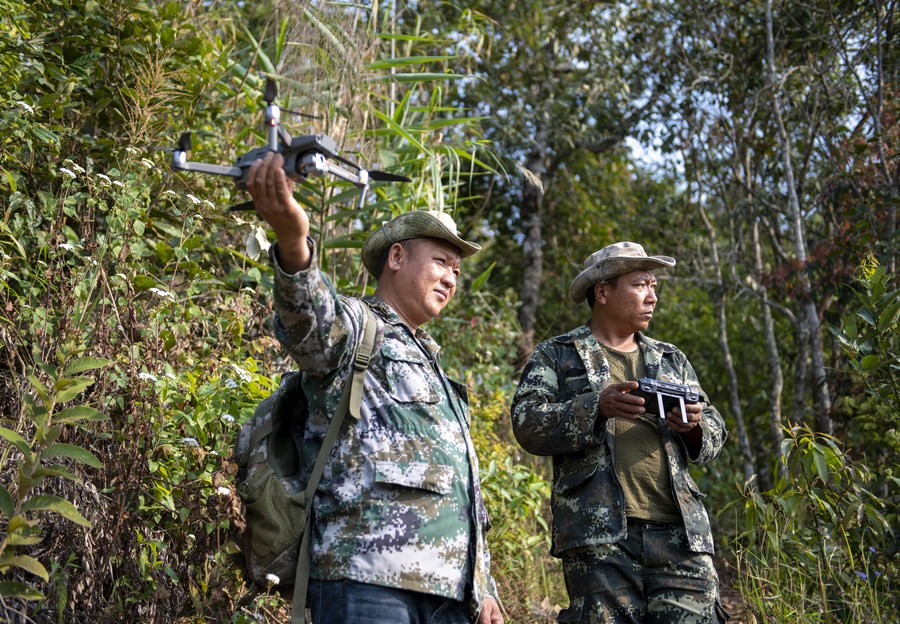
Monitors Peng Jinfu (R) and Pu Yongbing operate a drone to detect elephants approaching in Dadugang Township of Jinghong City, Xishuangbanna Dai Autonomous Prefecture, southwest China's Yunnan Province, March 14, 2022. (Xinhua/Chen Xinbo)
As of December 2021, this system had sent over 7,000 warnings to locals through real-time messages and broadcasts.
ECOLOGICAL RESTORATION
Much progress has been made on ecological restoration over the past few years, providing elephants with a better natural habitat to live in. However, the increase in habitat has been accompanied by a rise in elephant numbers.
"The population increase of Asian elephants is a success, but they also need more space to live in," said Arceiz.
Yunnan now has 362 nature reserves covering over 14 percent of its land. It means nearly every species has already been placed under some form of protection.
"What comes next should be the ecological restoration of the wildlife corridors for elephants to pass through," said Yang Yongping, head of the Xishuangbanna Tropical Botanical Garden.
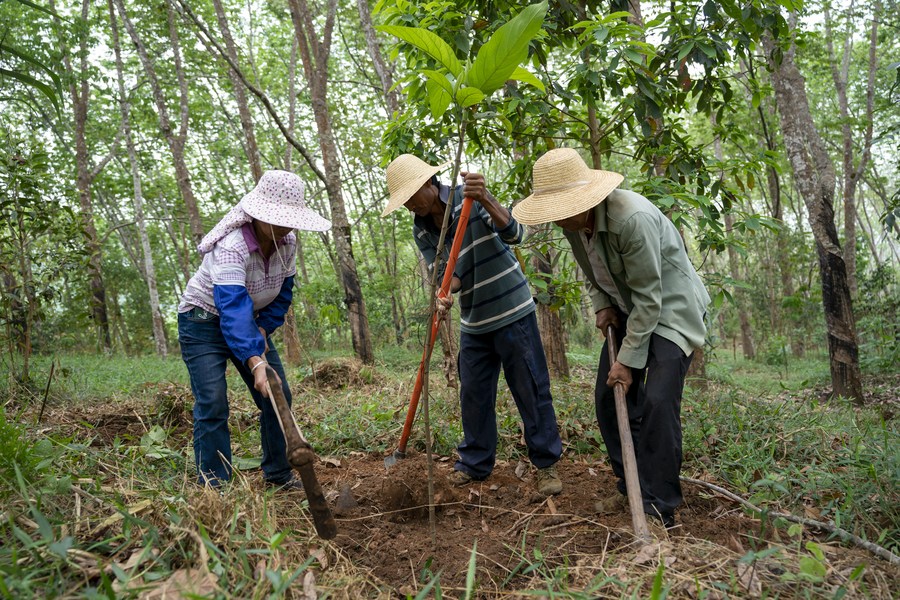
Villagers plant a tree at a rubber plantation in Xishuangbanna Dai Autonomous Prefecture, southwest China's Yunnan Province, on March 16, 2022. (Xinhua/Chen Xinbo)
To form such a big area, economic plantations such as rubber forests have to gradually give way to the original ecosystem. Institutions like the garden have already made some progress by growing tracts of artificial rainforest on former rubber plantations.
"In the future, we should focus more on the quality of these plantations, rather than just the quantity," said Yang.
Xishuangbanna plans for ecological restoration in about 36,200 hectares of rubber plantations and tea gardens during the 14th Five-Year Plan period (2021-2025).
"The ultimate aim should be that both humans and elephants can have their own way," said Guo. "And then, in the long run, man can live in harmony with nature."
(Video reporters: Sun Min, Zheng Bofei; Video editors: Wu Yao, Zhu Jianhui.)■


